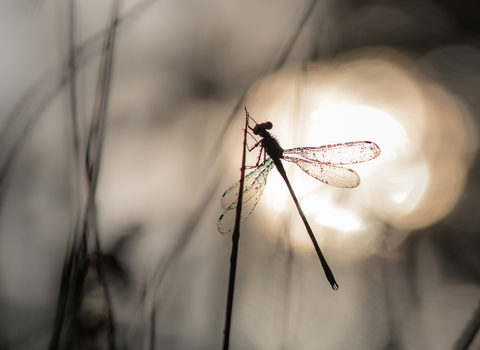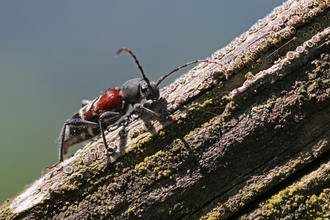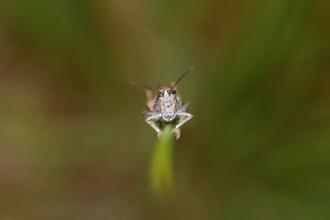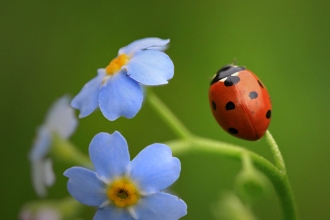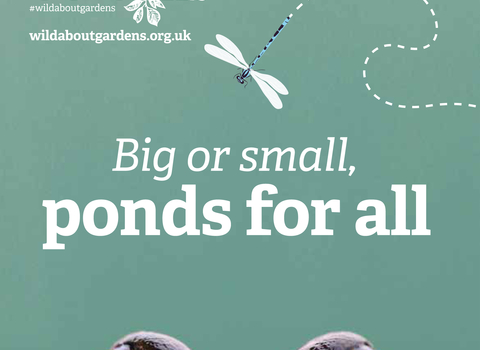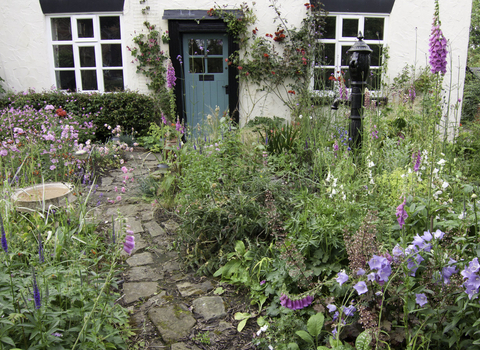With bright showy colours and unsurpassed aerial agility, who doesn’t stop to admire the dragonflies? With help from Worcestershire's dragonfly expert, Mike Averill, take a look below to help you spot and identify some of the less active but colourful damselflies as well as the masters of flight tricks, the dragonflies - you might even spot some in your your garden.
To spot dragons and damsels, head to your nearest water feature that keeps its water all year round. Ponds, whether in your garden or the wider landscape, should have shallow edges with a deep area and, very importantly, lots of vegetation around the edge, which not only allows dragonflies to display on but it also helps them to emerge from the water.
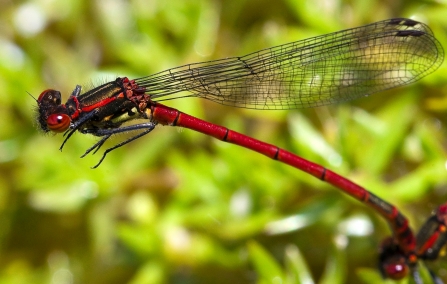
Large red damselfly by Pete Cheshire
Large red damselfly Pyrrhosoma nymphula
This is the first damselfly to emerge in the spring - they've been known to emerge as early as March but mid-April onwards is more usual. The name 'on the tin' (and the first part of its scientific name) gives away this delicate damselfly's main identifying feature - it's 'flame-coloured'. Females have more black markings on the abdomen but both sexes have black legs. Look for these damsels on almost any waterbody except those that are fast-flowing and if you spot one, please take a picture and report it to us via our short wildlife sightings form to help us discover more about where they are in Worcestershire.
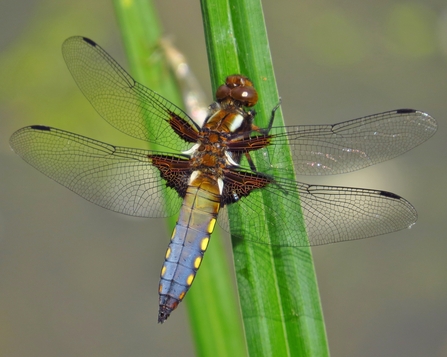
Broad-bodied chaser by Mike Averill
Broad-bodied chaser Libellula depressa
This medium-sized dragonfly readily finds new ponds so you might spot one in your garden if you're lucky enough to have a pond. After emerging, both sexes appear yellowish-brown and it takes a week or so for the male to develop a bluish abdomen. Amazingly this isn’t a real colour – it’s an arrangement of fatty scales that lie like roof tiles and give the impression of blue. The wings have dark brown patches at their base and, as the name suggests, both sexes are broad-bodied. It’s probably the easiest dragonfly to photograph as it tends to return to a favourite perch besides small ponds - if you're lucky enough to spot one doing this, please take a picture and let us know via our short wildlife sightings form.
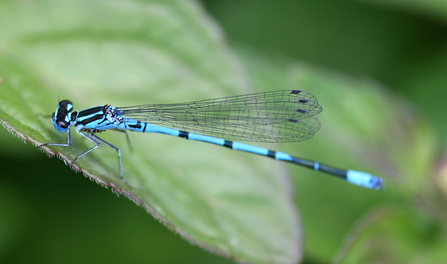
Azure damselfly by Wendy Carter
Azure damselfly Coenagrion puella
There are two medium-sized blue damselflies that can be easily confused - this one is the most likely of the two to be found in a garden. Males are blue and they have a distinct black line on the side of the thorax as well as a U-shaped black mark on segment 2 of the abdomen (seen in the photo just below where the wings meet the body). Females are green and black. Most individuals emerge from May and they can be seen flying in July and, occasionally, into August as well. Look for azure damselflies around small ponds and streams as well as the edges of larger water bodies.
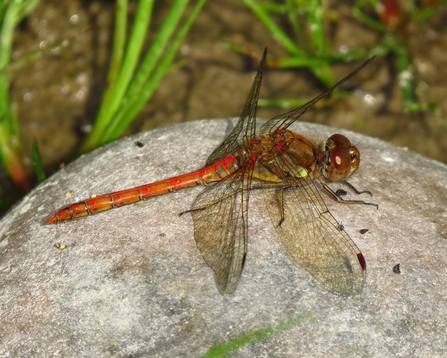
Common darter by Mike Averill
Common darter Sympetrum striolatum
This is the commonest of five darter dragonflies and is usually the last species seen in the autumn as it seeks out sunny spots. Mostly orange-red (males) and brownish (females), they have a favoured perch from which they like to dart out to catch their prey and then return. Dragonflies have bigger eyes than damselflies and this helps them to track and intercept flying prey. They have better colour vision than us with up to 33 colour cones, not just three! Look for common darter dragonflies around small ponds as well as along woodland rides where you may spot them hunting for food.
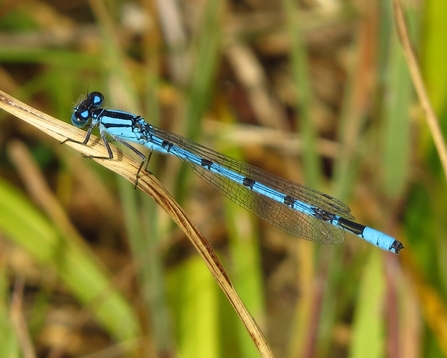
Common blue damselfly by Mike Averill
Common blue damselfly Enallagma cyathigerum
Easily mistaken for the azure damselfly, the common blue is a stronger flier and is more likely to be found on larger ponds and water bodies. Egg-laying in tandem, fleets of these can be seen heading out across large pools and lakes, all facing into the wind. The easiest way to separate common blue damselflies from azure is to look just below where the male's wings meet the body for a black-stalked spot (like a tee and golf ball). Abdominal segments eight & nine are completely blue in males. Females, on the other hand, can be blue or a dull green and rather than having a black-stalked spot, they have a thistle silhouette in the same place (abdominal segment two).
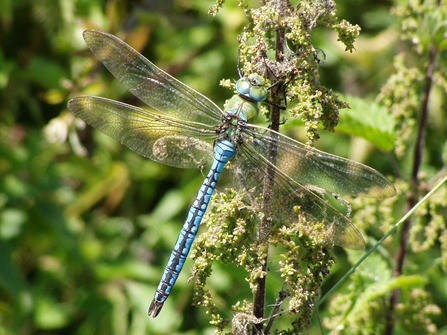
Emperor dragonfly by Mike Averill
Emperor Anax Imperator
Even though it's the largest of all our dragonflies, emperors may still be found flying over garden ponds as well as much larger water bodies where they can have tens of larvae hidden away for the three years that they spend underwater. Highly territorial males may not allow any other emperor in its territory, patrolling constantly. The thorax is apple green and the abdomen is green (female) or bright blue (male) with a striking central black line. They can frustrate photographers as they rarely land.
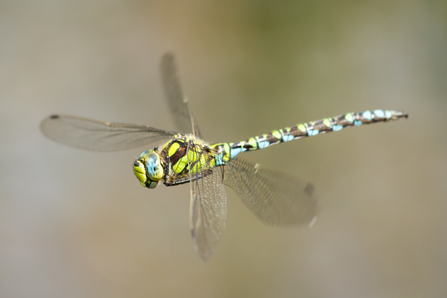
Southern hawker by Jonathan Cartwright
Southern hawker Aeshna cyanea
This is our largest hawker, mostly dark brown with a complex pattern of apple green markings - only the male has blue spots at the end of the abdomen. Females insert their eggs into plants, moss and rotting wood and they breed in small ponds, often in gardens. If encountered along a woodland ride they often investigate the intruder (you). The larvae are large enough to watch in a pond as they stalk their prey.
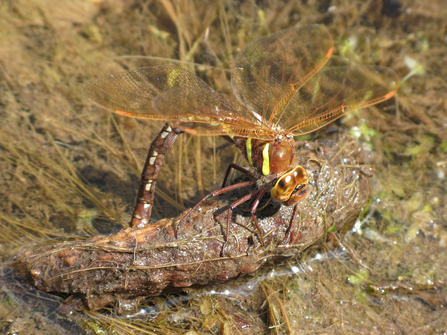
Brown hawker by Wendy Carter
Brown hawker Aeshna grandis
Worcestershire’s other common hawker is very easy to identify as it is all brown, even the wings are amber. They breed in slow-flowing and standing water and, like other hawkers, females lay their eggs unaccompanied by males. Males aren’t particularly territorial and are often seen away from water flying with bursts of speed interspersed with periods of gliding. We’ve still got lots to learn about this species such as why are they rarely seen in Wales and Cornwall.
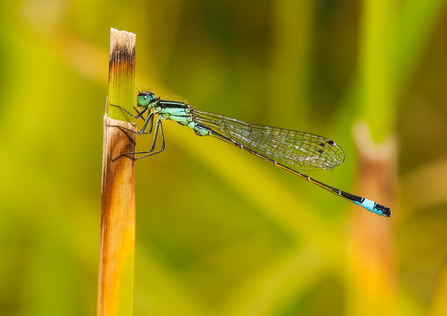
Blue-tailed damselfly by Peter Smith
Blue-tailed damselfly Ischnura elegans
This is a very widespread species that lives in all sorts of habitat including gardens. It has the obvious blue tip to the tail on segment eight (just before the end of the abdomen). To make things a bit more confusing, females can be one of five different colours and only three of these have the blue tail. One of the female forms is identical to the males - why might they do that? It is thought that they avoid harassment in the breeding season if they look like males.
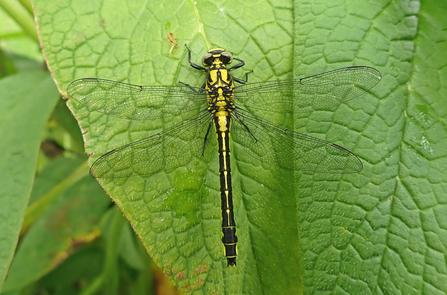
Common clubtail by Brett Westwood
Common clubtail Gomphus vulgatissimus
One of Worcestershire's rarer and most elusive dragonflies, as their name suggests, common clubtails have distinctively clubbed 'tails'. Both sexes are black and yellow although males can sometimes be lime green. They're found in only a handful of places across the UK but Worcestershire's rivers Severn and Teme are a stronghold for them. Until recently, they were also found on the River Avon but haven't been seen there for the last few years. If you see one anywhere in the county, please let us know.

